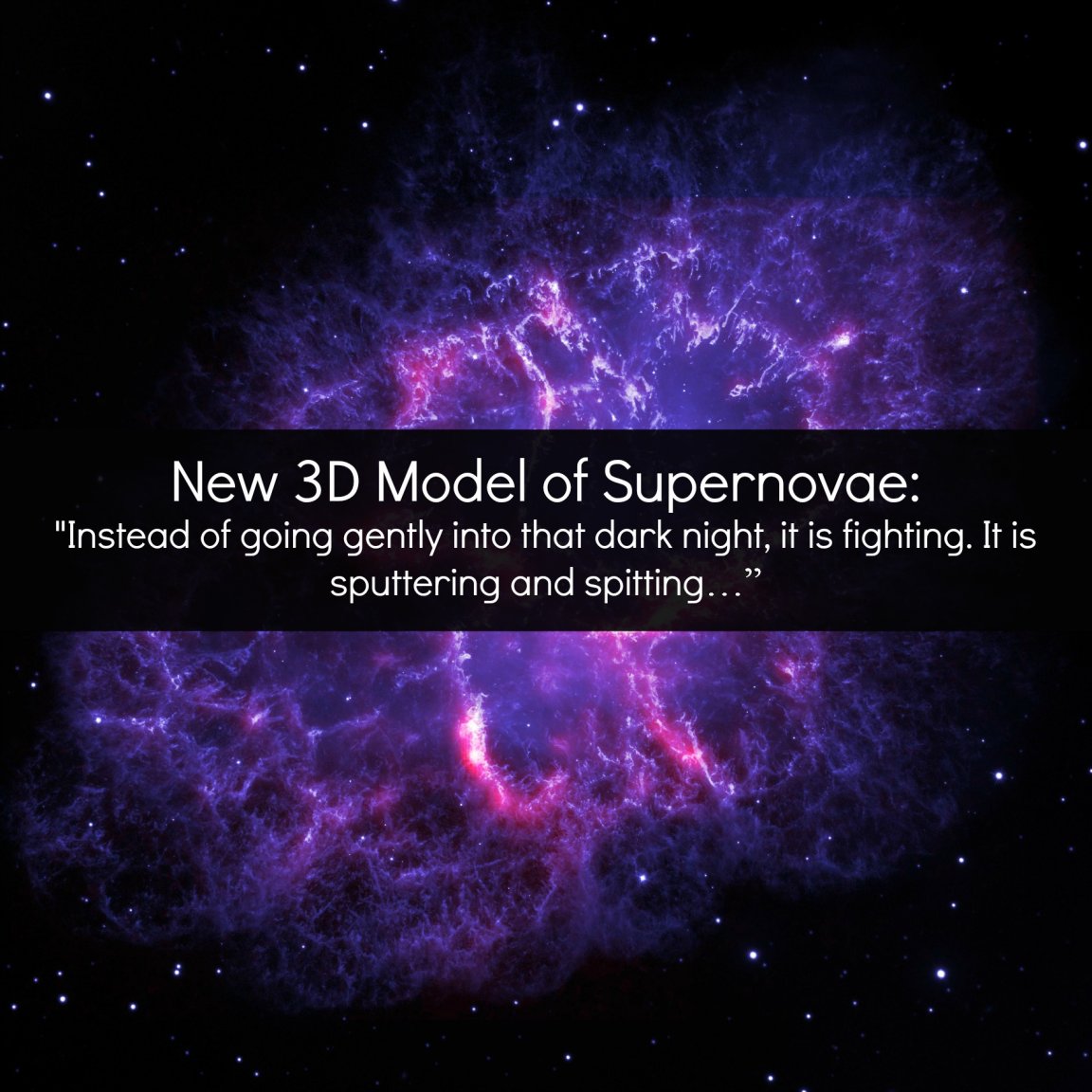

Supernovae are stellar explosions of cosmic proportions (literally). They are some of the most violent events in the known universe. A single supernova emits enough energy to outshine an entire galaxy. What’s more, these events are responsible for populating the universe with elements, and in so doing, making life on Earth possible.
And today, scientists announced that they have managed to peer into the heart of these beasts, so to speak.
A powerful, new three-dimensional model (developed by W. David Arnett, Regents Professor of Astrophysics at the University of Arizona) gives us new insight into the turbulent death throes of supernovae and offers an explanation for some unexplained phenomenon observed in previous explosions. Working in conjunction with individuals from Arizona and the Max-Planck Institut fur Astrophysik in Germany, Arnett developed a new rendering of the collapse, which is the first model to represent the start of a supernova in three dimensions.
The team carried out this work because of a mystery surrounding a supernova explosion in the outskirts of the Tarantula Nebula in the Large Magellanic Cloud (a nearby dwarf galaxy). The supernova in question is called SN 1987A, and it occurred some 168,000 light-years from our home planet, making it bright enough to witness with the naked eye. Ultimately, there were some things about the event that preexisting models could not explain and which puzzled astronomers. Namely, that the material ejected by the star’s explosion appeared to mix with material previously ejected from the star. This is a bit problematic.
Previous Model of Supernovae Collapse:
The previous model of collapse envisioned a star as a series of concentric circles. The heavier elements, such as iron and silicon, would be found in the center of the star. The lighter elements, such as carbon and helium, would be found towards the star’s surface. With this structure, models predicted that the heavier elements would exert a powerful gravitational pull on the lighter elements, ultimately resulting in the star being compressed.
When the star is compresses, the molecules speed up because they are colliding with the wall that is moving inward. This increase in collisions and movement causes and increase in temperature, making the star hot enough to create neutrinos. As these neutrinos go shooting out of the star, they take energy with them. This decrease in energy reduces the ability of the lighter gases to fight the core’s gravitational pull. Consequently, the star contracts further, and so on and so on until you have a runaway situation and, in the end, a supernova explosion.
Scientists formulated this model by analyzing the emissions from supernovae and then creating models that yield similar results. Since the data is so complex, scientists have to simplify the process in order to get it to run on supercomputers. They do this by limiting their models to one or perhaps two dimensions, and making assumptions about how flow in other dimensions might behave. In such models, the aforementioned shells dictate and control the explosion and keep the heavy and light material separate and stable.
New Model’s Revelations:
Arnett’s 3-D models show something entirely different. Instead of the ordered shells, we see a wild and turbulent interior that spits out star remnants prior to the final explosion.
Arnett explains, “We still have the concentric circles, with the heaviest elements in the middle and the lightest elements on top, but it is if someone put a paddle in there and mixed it around. As we approach the explosion, we get flows that mix the materials together, causing the star to flop around and spit out material until we get an explosion. We see those ejections of star material, and how they mix with material expelled from the star during its final explosion. Other models cannot explain this.”

In the above model, “Three-dimensional turbulent mixing in a stratified burning oxygen shell which is four pressure scale heights deep. The yellow ashes of sulphur are being dredged up from the underlying orange core. The multi-scale structure of the turbulence is prominent. Entrained material is not particularly well mixed, but has features which trace the large scale advective flows in the convection zone. Also visible are smaller scale features, which are generated as the larger features become unstable, breaking apart to become part of the turbulent cascade. The white lines indicate the boundary of the computational domain.”
In short, Arnett’s model is based on better data and faster, more powerful computers. Such feats were not possible when Arnett first began running the simulations four decades ago. He asserts, “It would have taken 40 years to run these models on the supercomputers I used in the 1970s [meaning these ultra complex simulations only would have completed their model a few short years ago]. They were feeble compared with my smartphone.”
Ultimately, it is exciting to think of what we may be able to uncover with the next wave of supercomputers. But regardless of where else these devices take us, one path, at least, is certain. With each leap forward we shall tunnel deeper and deeper into the death throes of the universe’s most massive stars.